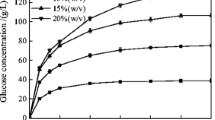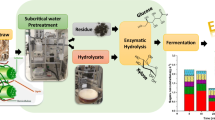Abstract
An abundant agricultural residue, rice straw (RS) was pretreated using ammonia fiber expansion (AFEX) process with less than 3% sugar loss. Along with commercial cellulase (Spezyme® CP) at 15 filter paper unit/g of glucan, the addition of Multifect® Xylanase at 2.67 mg protein/g glucan and Multifect® Pectinase at 3.65 mg protein/g glucan was optimized to greatly increase sugar conversion of AFEX-treated RS. During enzymatic hydrolysis even at 6% glucan loading (equivalent to 17.8% solid loading), about 80.6% of glucan and 89.6% of xylan conversions (including monomeric and oligomeric sugars) were achieved. However, oligomeric glucose and xylose accounted for 12.3% of the total glucose and 37.0% of the total xylose, respectively. Comparison among the three ethanologenic strains revealed Saccharomyces cerevisiae 424A(LNH-ST) to be a promising candidate for RS hydrolysate with maximum ethanol metabolic yield of 95.3% and ethanol volumetric productivity of 0.26 g/L/h. The final concentration of ethanol at 37.0 g/L was obtained by S. cerevisiae 424A(LNH-ST) even with low cell density inoculum. A biorefinery combining AFEX pretreatment with S. cerevisiae 424A(LNH-ST) in separate hydrolysis and fermentation could achieve 175.6 g EtOH/kg untreated rice straw at low initial cell density (0.28 g dw/L) without washing pretreated biomass, detoxification, or nutrient supplementation.






Similar content being viewed by others
References
Balan V, da Costa Sousa L, Chundawat SP, Vismeh R, Jones AD, Dale BE (2008) Mushroom spent straw: a potential substrate for an ethanol-based biorefinery. J Ind Microbiol Biotech 35:293–301
Bayrock DP, Ingledew WM (2001) Application of multistage continuous fermentation for production of fuel alcohol by very-high-gravity fermentation technology. J Ind Microbiol Biotech 27:87–93
Belkacemi K, Turcotte G, Halleux D, Savoie P (1998) Ethanol production from AFEX-treated forages and agricultural residues. Appl Biochem Biotechnol 70–72:441–462
Berlin A, Maximenko V, Gilkes N, Saddler J (2007) Optimization of enzyme complexes for lignocellulose hydrolysis. Biotechnol Bioeng 97:287–296
Bothast RJ, Schlicher MA (2005) Biotechnological processes for conversion of corn into ethanol. Appl Microbiol Biotechnol 67:19–25
Bradshaw TC, Alizadeh H, Teymouri F, Balan V, Dale BE (2007) Ammonia fiber expansion pretreatment and enzymatic hydrolysis on two different growth stages of reed canarygrass. Appl Biochem Biotechnol 137–140:395–405
Byung-Hwan U, Hanly TR (2008) High-solid enzymatic hydrolysis and fermentation of solka floc into ethanol. J Microbiol Biotechnol 18:1257–1265
Chandawat SPS, Balan V, Dale BE (2007) Effect of particle size based separation of milled corn stover on AFEX pretreatment and enzymatic digestibility. Biotechnol Bioeng 96:219–231
Chang VS, Holtzapple MT (2000) Fundamental factors affecting biomass enzymatic reactivity. Appl Biochem Biotechnol 84–86:5–37
Cohen R, Persky L, Hadar Y (2002) Biotechnological applications and potential of wood-degrading mushrooms of the genus Pleurotus. Appl Microbiol Biotechnol 58:582–594
Dien BS, Ximenes EA, O'Bryan PJ, Moniruzzaman M, Li XL, Balan V, Dale B, Cotta MA (2008) Enzyme characterization for hydrolysis of AFEX and liquid hot-water pretreated distillers' grains and their conversion to ethanol. Bioresour Technol 99:5216–5225
Eriksson T, Karlsson J, Tjerneld F (2002) A model explaining declining rate in hydrolysis of lignocellulosic substrates with cellobiohydrolase I (Cel7A) and endoglucanase I (Cel7B) of Trichoderma reesei. Appl Biochem Biotechnol 101:41–60
Fan ZL, South C, Lyford K, Munsie J, van Walsum P, Lynd LR (2003) Conversion of paper sludge to ethanol in a semicontinuous solids-fed reactor. Bioprocess Biosyst Eng 26:93–101
Farone WA, Cuzens JE (1996) Method of producing sugars using strong acid hydrolysis of cellulosic and hemicellulosic materials. US Patent 5,562,777
Farrell AE, Plevin RJ, Turner BT, Jones AD, O'Hare M, Kammen DM (2006) Ethanol can contribute to energy and environmental goals. Science 311:506–508
Forrest L, Williams J, Collin I, Holtzer R, Lindberg D, Maben L, Merz J, Parsons G, Waite W (1997) Report of the Advisory Committee on alternatives to rice straw burning. California Air Resources Board and California Department of Food and Agriculture, Sacramento, CA
Gollapalli LE, Dale BE, Rivers DM (2002) Predicting digestibility of ammonia fiber explosion (AFEX) treated rice straw. Appl Biochem Biotechnol 98–100:23–35
Goodman EF (1996) Moisture absorbing materials and methods of production. US Patent 5,503,931
Ho NWY, Chen ZD (1997) Stable recombinant yeasts capable of effective fermentation of both glucose and xylose. PCT Patent No. WO97/42307
Jin SY, Chen HZ (2006) Structure properties and enzymatic hydrolysis of rice straw. Process Biochem 41:1261–1264
Jørgensen H, Vibe-Pedersen J, Larsen J, Felby C (2007) Liquefaction of lignocellulose at high-solids concentrations. Biotechnol Bioeng 96:862–870
Lau MW, Dale BE (2009) Cellulosic ethanol production from AFEX-treated corn stover using Saccharomyces cereviasiae 424A(LNH-ST). Proc Natl Acad Sci USA 106:1368–1373
Lau MW, Dale BE, Balan V (2008) Ethanolic fermentation of hydrolysates from ammonia fiber expansion (AFEX) treated corn stover and distillers grain without detoxification and external nutrient supplementation. Biotechnol Bioeng 99:529–539
Lin Y, Tanaka S (2006) Ethanol fermentation from biomass resources: current state and prospects. Appl Microbiol Biotechnol 69:627–642
Lu P, Davis BP, Hendrick J, Jeffries TW (1998) Cloning and disruption of the beta-isopropylmalate dehydrogenase gene (LEU2) of Pichia stipitis with URA3 and recovery of the double auxotroph. Appl Microbiol Biotechnol 49:141–146
Lu Y, Wang Y, Xu G, Chu J, Zhuang Y, Zhang S (2008) Influence of high solid concentration on enzymatic hydrolysis and fermentation of steam-exploded corn stover biomass. Appl Biochem Biotechnol. doi:https://doi.org/10.1007/s12010-008-8306-0
Lübbert A, Jøgensen BS (2001) Bioreactor performance: a more scientific approach for practice. J Biotechnol 85:187–212
Mansfield SD, Mooney C, Saddler JN (1999) Substrate and enzyme characteristics that limit cellulose hydrolysis. Biotechnol Prog 15:804–816
NREL (2004) Laboratory analytical procedure (LAP). http://www.nrel.gov/biomass/analytical_procedures.html
Rudolf A, Baudel H, Zacchi G, Hahn-Hägerdal B, Lidén G (2008) Simultaneous saccharification and fermentation of steam-pretreated bagasse using Saccharomyces cerevisiae TMB3400 and Pichia stipitis CBS6054. Biotechnol Bioeng 99:783–790
Sedlak M, Ho NW (2004) Production of ethanol from cellulosic biomass hydrolysates using genetically engineered Saccharomyces yeast capable of cofermenting glucose and xylose. Appl Biochem Biotechnol 113–116:403–416
Skoog K, Hahn-Hagerdahl B (1990) Effect of oxygenation on xylose fermentation by Pichia stipitis. Appl Environ Microbiol 56:3389–3394
Skoog K, Hahn-Hägerdal B, Degn H, Jacobsen JP, Jacobsen HS (1992) Ethanol reassimilation and ethanol tolerance in Pichia stipitis CBS 6054 as studied by C nuclear magnetic resonance spectroscopy. Appl Environ Microbiol 58:2552–2558
Soest PJV (2006) Rice straw, the role of silica and treatments to improve quality. Anim Feed Sci Technol 130:137–171
Sreenath HK, Jeffries TW (1997) Diminished respirative growth and enhanced assimilative sugar uptake result in higher specific fermentation rates by the mutant Pichia stipitis FPL-061. Appl Biochem Biotechnol 63–65:109–116
Tengborg C, Galbe M, Zacchi G (2001) Influence of enzyme loading and physical parameters on the enzymatic hydrolysis of steam-pretreated softwood. Biotechnol Prog 17:110–117
Teymouri F, Laureano-Perez L, Alizadeh H, Dale BE (2006) Optimization of the ammonia fiber explosion (AFEX) treatment parameters for enzymatic hydrolysis of corn stover. Bioresour Technol 96:2014–2018
Wingren A, Galbe M, Zacchi G (2003) Techno-economic evaluation of producing ethanol from softwood: comparison of SSF and SHF and identification of bottlenecks. Biotechnol Prog 19:1109–1117
Xiao ZZ, Zhang X, Gregg DJ, Saddler JN (2004) Effects of sugar inhibition on cellulases and beta-glucosidase during enzymatic hydrolysis of softwood substrates. Appl Biochem Biotechnol 113–116:1115–1126
Zacchi G, Axelsson A (1989) Economic evaluation of preconcentration in production of ethanol from dilute sugar solutions. Biotechnol Bioeng 34:223–233
Acknowledgments
We would like to thank Dr. Thomas W. Jeffries for providing the engineered Pichia stipitis strains. We deeply appreciate the valuable suggestions given by both Leonardo daCosta Sousa and Shishir Chundawat during the course of this experiment. The authors are grateful for the financial support from the Michigan State University Research Foundation through SPG grants and the National Natural Science Foundation of China (Key Program Grant No. 20736006), the National Basic Research Program of China (“973” Program: 2007CB714301), the International Collaboration Project of MOST(2006DFA62400), and key projects in the National Science & Technology Pillar Program (No. 2007BAD42B02). We would like to thank Genencor for generously supplying Spezyme® CP cellulase, Multifect® xylanase, and Multifect® pectinase for our research.
Author information
Authors and Affiliations
Corresponding author
Rights and permissions
About this article
Cite this article
Zhong, C., Lau, M.W., Balan, V. et al. Optimization of enzymatic hydrolysis and ethanol fermentation from AFEX-treated rice straw. Appl Microbiol Biotechnol 84, 667–676 (2009). https://doi.org/10.1007/s00253-009-2001-0
Received:
Revised:
Accepted:
Published:
Issue Date:
DOI: https://doi.org/10.1007/s00253-009-2001-0




